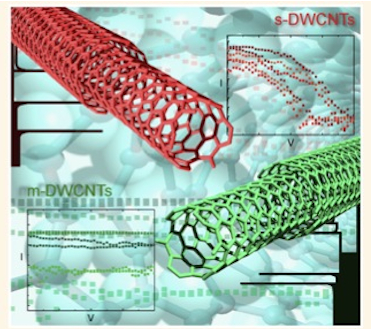When carbon nanotubes are made, a mixture of single-, double- and multi-walled nanotubes are produced. The nanomaterials are also produced as a mix of both metallic and semiconducting tubes. This is a real problem when trying to make electronic devices from these structures because, ideally, either semiconducting or metallic tubes are needed depending on the application and not both. What is more, the tubes should either be predominantly single-, double- or multi-walled. Now, researchers in Germany and Australia have developed a new gel permeation method that can not only separate out double-walled tubes from the nanotube mix, but which can also distinguish the nanotubes by their electronic type. The purified tubes might now be used in real-world devices such field-effect transistors, sensors and transparent electrodes.

Getting sorted: metallic and semiconducting DWCNTs
Carbon nanotubes (CNTs) are rolled-up sheets of graphite just one atom thick and can be metallic or semiconducting depending on the direction in which the sheet has been rolled. They could be ideal as the building blocks in nanoscale electronics thanks to their small size and their ability to carry large currents. Metallic tubes could be used to make transparent conducting leads, for example, while semiconducting tubes could make good nanoscale transistors. Double-walled CNTs, for their part, could also be ideal as biosensors because their outer walls can be chemically modified (or functionalised) while their inner walls can be left intact for signal transduction.
Last year,Benjamin Flavel and colleagues from the Karlsruhe Institute of Nanotechnology in Germany, and co-workers in Darmstadt, Ulm and Adelaide, succeeded in separating out double-walled CNTs from a mix of single-, double- and multi-walled nanotubes thanks to a column chromatography technique. Now, the team has gone a step further in its experiments and has managed to sort the DWCNTs thus obtained by their electronic type too. “Having DWCNTs that are separated and electronically purified in this way will now allow us to use them in devices such as nanotube-based field-effect transistors,” Flavel tells nanotechweb.org.
Surfactant interacts differently with metallic and semiconducting tubes
The teams previous technique involved placing an as-prepared solution of nanotubes that had been solvent-stabilised using sodium dodecyl sulphate and passing this solution through a column containing the chemical gel Sephacryl S-200. They then rinsed the solution with sodium cholate. The separated material was collected at the other end, and was found to be richer in DWCNTs compared to single- and multi-walled CNTs. This was because the DWCNTs travel faster through the S-200 gel compared with the SWCNTs and therefore came out first from the column.
The new gel permeation method again makes use of S-200 but also exploits the fact that small changes to the surfactant shell allow the surfactant to interact differently with metallic and semiconducting nanotubes.
Researchers believe that small diameter metallic single-walled nanotubes are more “wrapped” than semiconducting ones and this also appears to be true for double-walled CNTs (which have a larger diameter, of around 1.5 nm). However, because of this larger diameter, the difference between metallic and semiconducting species is reduced, explains Flavel and we have to start “playing tricks” with the surfactant shell to separate the structures by electronic type. “In our work, we did this by using co-surfactant mixtures to stabilize the DWCNTs and tailor their interaction with the S-200 gel.”
"Interesting" new work
Zhenan Bao of Stanford University in the US thinks that this new work is “interesting”. “DWNTs are great metallic CNTs and being able to separate them [using such techniques] will allow for high performance transparent electrodes.”
Flavel and colleagues say that they still have much to do and that so far, they have only been able to control the outer wall of a DWCNT using their technique. “This is only half the story,” says Flavel, “and there is, of course, an inner wall in these nanostructures. The ultimate in control would be DWCNTs with electronically defined inner and outer walls – but this is going to be a little more challenging because we do not have access to the inner wall with commonly employed solution processing techniques. Only time will tell what we will come up with to address this problem.”

